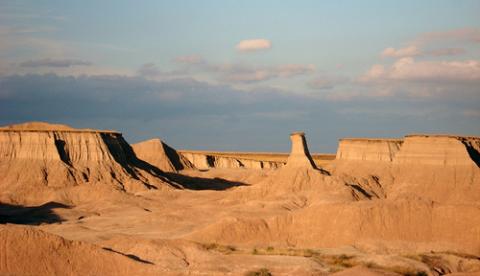Given birth as a national monument in 1939 and then transformed into a national park in 1978, Badlands National Park marks its 29th birthday today. Across its 244,000 acres you'll find vestiges of prehistoric life, the largest expanse of protected prairie in the park system, and a rebounding mammal once thought bound for extinction.
Badlands, which is located 88 miles southeast of Rapid City, South, Dakota, is a geologist's dream with its eroded panorama. In the making for millions of years, the buttes, spires and minaretes that stand today were pieced together by sediments from a vast inland sea, from a river system, and even from volcanic ash. Today this landscape holds puzzle pieces that geologists and paleontologists are assembling to better understand the prehistoric world that once existed here.
Among the fossils that have been recovered in Badlands National Park are those from "Subhyracodon," a hornless rhino; "Archaeotherium," a pig-like creature, and; many from ancient turtles, three-toed horses, and a saber-toothed cat the size of a bobcat.
It was in 1976 that the park movement really took hold at Badlands. At the time a national monument, an agreement was struck in that year with the Oglala Lakota Nation to co-manage and protect 122,000 acres south of Highway 44 to go along with the existing "North Unit" of roughly the same size. That agreement effectively doubled the size of the monument and led to Congress' decision in 1978 to turn the monument into a national park. In the 29 years since that designation was made, crews have continued to look for, and remove, unexploded military ordinance from the park's South Unit, which served as a bombing range during the second World War.
The national park is home to a burgeoning population of black-footed ferrets, which had been thought to be extinct until one was found in northwestern Wyoming in 1981. From a captive-bred population nurtured by the U.S. Fish and Wildlife Service and Wyoming Game and Fish Department, the population of black-footed ferrets has rebounded, although the species is still considered endangered.
Badlands contains two designated campgrounds. The main one is the 96-site Cedar Pass Campground that is run on a first-come, first-served basis. For $10 a night you'll find cold running water, flush toilets, covered picnic tables, and not much else. Campfires are not permitted because of the risk of igniting a prairie fire.
The Sage Creek Primitive Campground is open year-round at no cost, but the road that runs to it is unpaved and can be troublesome for large RVs and during the rainy season. There is no running water here, though there are pit toilets and picnic tables. Again, campfires are not permitted.
There is no fee and no permit required for backcountry camping, but it's recommended that you let the folks at the Ben Reifel Visitor Center or the Pinnacles Ranger Station know that you're heading out into the park. There is one significant obstacle to extended backcountry travel: The little water you might come across is not considered drinkable nor filterable because of its sediment loads. As a result, you'll need to pack in all the water you need, and the suggested amount of one gallon a day per person can become quite hefty if you're planning to be out for more than a few days.
There are a number of day hikes in the park, ranging from the quarter-mile Window Trail that leads to a natural window in Badlands Wall to the 10-mile-long Castle Trail, an out-and-back trek (5 miles each way) through some Badlands formations to the quarter-mile-long Fossil Exhibit Trail.
When to go? October sounds just about perfect, with daily highs averaging around 68 degrees, overnight lows just below 40 degrees, and monthly precipitation averaging less than an inch.
There's a $15 fee to enter the park.




Comments
I had the experience of visiting this vast land filled with, what ilooked like giant sand castles. It was truly unbelievable. If one can think of the history that has past though this unforgiving land, it is remarkable. From the dinosaurs to the early homesteaders, to our native Indians, to present day vacationers. I was awe struck. At times I felt as though I was on a distant planet, until a mule deer, chipmunk, prairedog,wolf and many other wildlife past in front of our car. I am hoping to return agoin with our grandchildren.
It might be worth mentioning, that some of the most impressive scenes of the 1990 movie "Dances with Wolves" were filmed in the park. Particularly the early scene of a stagecoach driving through the prairie and the indian village at the river bend.
PS: Since about a week, i never get the captcha right in the first place, either the captcha isn't displayed at all or the first try fails. The second attempt always go through. Maybe there is an issue with Firefox, would you please check this out?
We travel to Wymong as often as we can. Each time, we visit the Badlands and twice have camped there. In addition to running water and toilets, there are showers, a General Store and even a play area for the kids. The first time, we camped in a tent; subsequently, we "camped" in their Camping Cabins which can comfortably accomodate four adults. The sunrise and sunset is magical with its creeping shades of tan, rose and gold on every rock formation. As you stand in the quiet of the place, you feel as if you've returned to a land of long ago. The Badlands is one of my favorite places to visit. It's a place of serene beauty.
One can only try to imagine what it must have been like for pioneers traveling for months across a never ending sea of prairie and then mountains and then this! THE BADLANDS